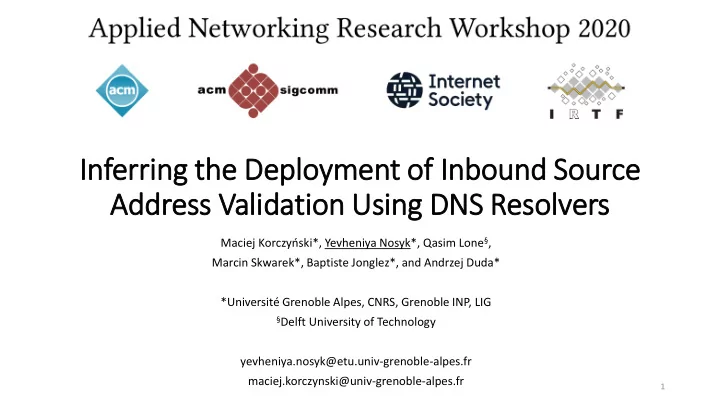

In Inferring the Deployment of f In Inbound Source Address Validation Using DNS Resolvers Maciej Korczyński*, Yevheniya Nosyk*, Qasim Lone § , Marcin Skwarek*, Baptiste Jonglez*, and Andrzej Duda* *Université Grenoble Alpes, CNRS, Grenoble INP, LIG § Delft University of Technology yevheniya.nosyk@etu.univ-grenoble-alpes.fr maciej.korczynski@univ-grenoble-alpes.fr 1
What is IP address spoofing? • Modification of the source IP address of the packet • Anonymity of the sender • Cause of DDoS attacks • GitHub DDoS attack of 28.02.2018 https://www.cloudflare.com/learning/ddos/glossary/ip-spoofing/ 2
Source Address Validation • Defined in BCP-38 (RFC 2827) in 2000 • Spoofed packets to be dropped at the network edge • Two directions: inbound and outbound 3
What is the state of deployment of Source Address Validation by network providers? 4
Existing work on SAV compliance • The Spoofer 1 • Forwarders-based method 2,3 • Traceroute loops 4 • Passive detection 5,6,7 1 https://www.caida.org/projects/spoofer 2 Mauch, J.: Spoofing ASNs, http://seclists.org/nanog/2013/Aug/132 3 Kührer, M., Hupperich, T., Bushart, J., Rossow, C., Holz, T.: Going Wild: Large-Scale Classication of Open DNS Resolvers. In: IMC, ACM (2015) 4 Lone, Q., Luckie , M., Korczyński, M., van Eeten, M.: Using Loops Observed in Traceroute to Infer the Ability to Spoof. In: PAM (2017) 5 Lichtblau, F., Streibelt, F., Krüger, T., Richter, P., Feldmann, A.: Detection, Classification, and Analysis of Inter-domain Traffic with Spoofed Source IP Addresses. In: IMC, ACM (2017) 6 Müller, L.F., Luckie, M.J., Huffaker, B., kc claffy, Barcellos, M.P.: Challenges in Inferring Spoofed Traffic at IXPs. In: CoNEXT, ACM (2019) 7 Jasper Eumann, Raphael Hiesgen, Thomas C. Schmidt, Matthias Wählisch. arXiv:1911.05164 [cs.NI] (2019) 5
What do we propose and why? • Measuring inbound SAV compliance. Why inbound ? Because: • NXNSAttack 1 • Windows DNS Server Remote Code Execution Vulnerability (SigRead) 2 • Zone poisoning 3 • Completely remote • Covering the whole routable IPv4 space • Not relying on misconfigurations 1 Lior Shafir, Yehuda Afek, Anat Bremler-Barr. NXNSAttack: Recursive DNS Inefficiencies and Vulnerabilities. In: USENIX Security (2020) 2 https://portal.msrc.microsoft.com/en-US/security-guidance/advisory/CVE-2020-1350 3 Zone Poisoning: The How and Where of Non-Secure DNS Dynamic Updates. Maciej Korczynski, Michal Krol, and Michel van Eeten. In: IMC (2016) 6
Methodology 7
Methodology • The proposed method detects the absence of inbound SAV. • How to detect its presence ? • Follow each spoofed packet with a non-spoofed one! • Overcomes major limitations of existing work • Follows ethical scanning principles 8
Results • Scan performed in December 2019 • 5,651,672,542 spoofed and non-spoofed packets sent • 6,946,782 vulnerable resolvers: • 4,589,251 closed • 2,357,531 open • Vulnerable resolvers come from: • 32,673 autonomous systems (49.34%) • 197,641 BGP prefixes (23.61%) • 959,666 /24 IPv4 networks (8.62%) 9
Presence vs. Absence of SAV • Significantly more networks do not deploy inbound SAV than deploy it • Many filter partially: • 38,47% of autonomous systems • 22,37% of BGP prefixes • 12,30% of /24 IPv4 networks • Why? • Packet losses • Rescanned a sample of 1000 /24 partially vulnerable networks • 50% immediately became consistent (all vulnerable to spoofing) • Done on purpose • Confirmed by network operators 10
Outbound vs. Inbound Filtering • Inbound SAV – protects the network itself • Outbound SAV – protects other networks • Assumption: inbound filtering is more deployed than outbound 11
Outbound vs. Inbound Filtering • Comparison with the Spoofer data • 559 common /24 networks: • 95 do not filter in either direction • 151 filter in both directions • 298 filter only outbound traffic • 15 filter only inbound traffic • Inbound filtering is less deployed than outbound 12
Conclusions • Novel method to infer inbound SAV deployment 1,2 • Internet-wide measurement study • Over 49% of ASes and 23% of the longest matching BGP prefixes are vulnerable to inbound IP spoofing • Notification campaign in the near future • Follow-up study 3 • 25,47 % of IPv6 autonomous systems are vulnerable to inbound spoofing • SAV is less deployed in IPv6 than IPv4 1 Korczyński M., Nosyk Y., Lone Q., Skwarek M., Jonglez B., Duda A. Don’t Forget to Lock the Front Door! Inferring the Deployment of Source Address Validation of Inbound Traffic. In: Passive and Active Measurement Conference (2020). 2 Korczyński M., Nosyk Y., Lone Q., Skwarek M., Jonglez B., Duda A. Inferring the Deployment of Inbound Source Address Validation Using DNS Resolvers. In: ANRW (2020). 3 Korczyński M., Nosyk Y., Lone Q., Skwarek M., Jonglez B., Duda A. The Closed Resolver Project: Measuring the Deployment of Source Address Validation of Inbound Traffic. arXiv:2006.05277 [cs.NI] (2020) 15
Acknowledgements • This work has been carried out in the framework of the PrevDDoS project funded by the IDEX Université Grenoble Alpes and supported by the Grenoble Alpes Cybersecurity Institute. • Thanks to network operators: Roland M. van Rijswijk-Deij (University of Twente), Willem Toorop (NLnet Labs), Baptiste Jonglez (Tetaneutral.net), Niels Raijer (Fusix Networks) 16
Are you vulnerable to inbound spoofing? Contact us! closedresolver.com maciej.korczynski@univ-grenoble-alpes.fr yevheniya.nosyk@etu.univ-grenoble-alpes.fr 17
Questions? maciej.korczynski@univ-grenoble-alpes.fr yevheniya.nosyk@etu.univ-grenoble-alpes.fr 18
Recommend
More recommend